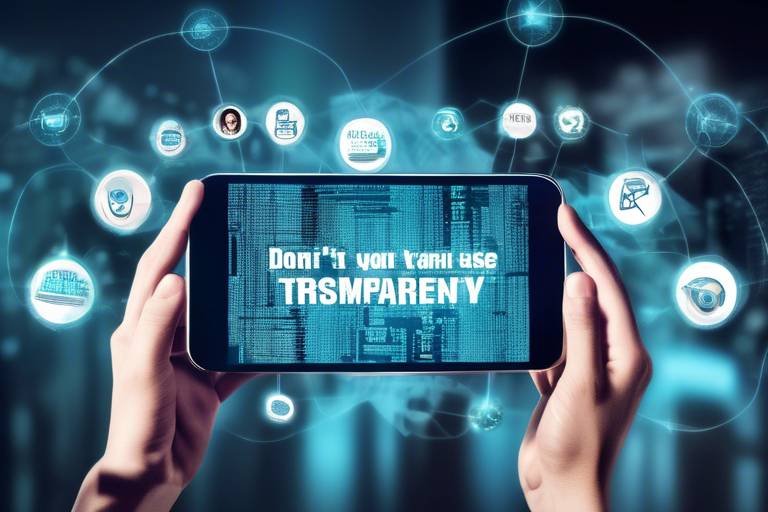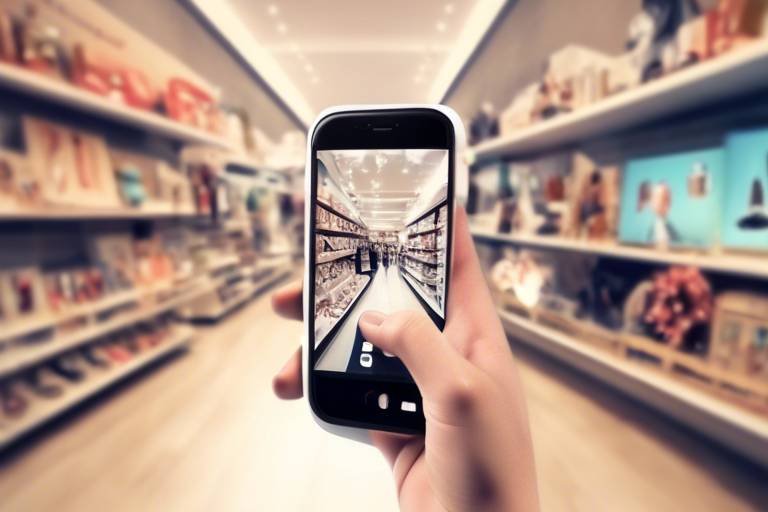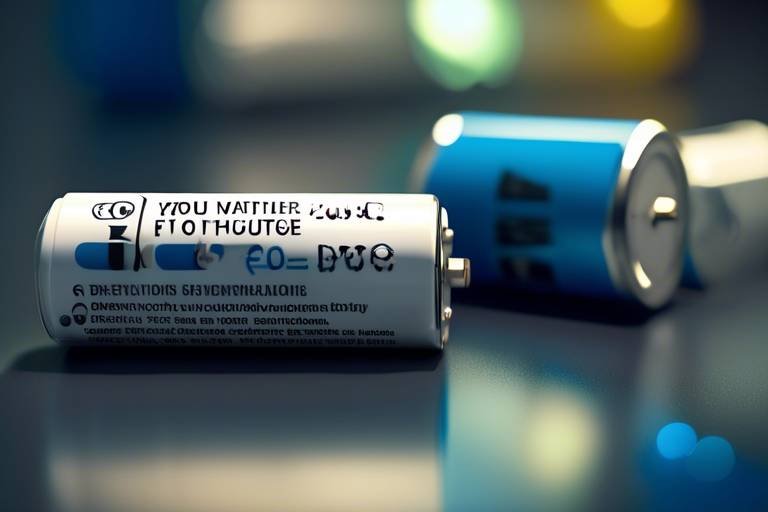The Role of Wearable Tech in Emergency Response
In today's fast-paced world, the integration of wearable technology into emergency response systems is nothing short of revolutionary. Imagine a scenario where every second counts, and first responders are equipped with devices that not only track their vital signs but also facilitate instant communication and navigation. This is the transformative power of wearable tech in emergency situations. The potential to save lives and improve outcomes is immense, and as we delve into this topic, we will explore how these devices are reshaping the landscape of emergency services.
Wearable technology encompasses a range of devices that can be worn on the body, such as smartwatches, fitness trackers, and specialized medical equipment. These devices are designed to collect and transmit real-time data, making them invaluable in emergency response scenarios. Understanding the fundamentals of wearable tech is essential for grasping its role in enhancing response efficiency. By enabling continuous monitoring and communication, these devices empower first responders to make critical decisions on the fly, ensuring that they can act swiftly and effectively in high-stress environments.
Wearable tech is revolutionizing emergency services in several key ways. For instance, paramedics and firefighters can now monitor vital signs through wearable devices, allowing them to assess the health status of victims immediately. This capability not only aids in treatment decisions but also helps in resource allocation during emergencies. Moreover, GPS-enabled wearables ensure that emergency responders can navigate efficiently to the scene, minimizing delays and enhancing coordination among various teams. The integration of these technologies is not just a trend; it is a necessary evolution in the way we approach emergency management.
One of the standout features of wearable devices is their health monitoring capabilities. These devices can track heart rates, oxygen levels, and other vital signs in real-time. For first responders, this means having the ability to assess a victim's health status instantly. Imagine being able to determine whether someone is in shock or experiencing a cardiac event within moments of arriving on the scene. This information can significantly influence treatment decisions and ensure that the right resources are allocated efficiently. In a field where every second matters, such capabilities can make all the difference.
GPS-enabled wearables are another game-changer in emergency response. These devices provide real-time location tracking, ensuring that emergency responders can navigate to the scene without delay. This technology is particularly beneficial in urban environments where traffic and other obstacles can impede timely access. By minimizing delays, GPS tracking enhances coordination among various emergency teams, allowing them to work together more effectively. The ability to pinpoint exact locations in real-time is akin to having a map that updates with every move, guiding responders through the chaos of an emergency.
Effective communication is crucial during emergencies, and integrated communication tools in wearable devices facilitate seamless information exchange among emergency personnel. Imagine a scenario where paramedics can instantly relay critical information to hospitals while en route, allowing medical staff to prepare for the arrival of patients. This connectivity is vital for quick decision-making and collaborative efforts during crises. Wearable tech acts as a lifeline, ensuring that everyone involved in the emergency response is on the same page, which ultimately leads to better outcomes for those in need.
Despite their numerous advantages, wearable technologies face several challenges that must be addressed. Issues such as battery life, data security, and user training can hinder their effectiveness in emergency situations. For instance, if a device runs out of battery during a critical moment, it could compromise the entire operation. Additionally, ensuring that sensitive health data remains secure is paramount, especially in an age where cyber threats are rampant. Training users to effectively utilize these technologies is equally important. Without proper training, even the most advanced devices can become underutilized or misused.
Analyzing real-world case studies demonstrates the successful integration of wearable tech in emergency response. For example, a city in California implemented wearable devices for its fire department, resulting in a 30% reduction in response times. These examples highlight best practices and outcomes that can guide future implementations. By learning from these case studies, other emergency services can adopt similar strategies to enhance their operations and ultimately save more lives.
The future of wearable technology in emergency response looks promising. With advancements in AI, machine learning, and connectivity, we can expect to see even more sophisticated capabilities in the coming years. Imagine wearable devices that can predict health crises before they occur or those that can communicate with each other to share vital information instantaneously. These innovations will likely redefine emergency management strategies, making them more proactive rather than reactive.
In conclusion, the integration of wearable technology in emergency response is crucial for improving efficiency and effectiveness. As we move forward, stakeholders must consider investing in training and infrastructure to fully leverage these innovations. By addressing the challenges and embracing the potential of wearable tech, we can enhance our emergency response systems and ultimately save lives.
- What types of wearable tech are used in emergency response? Common devices include smartwatches, health monitors, and GPS trackers.
- How does wearable tech improve response times? By providing real-time data and navigation tools, responders can reach emergencies more quickly.
- What are the main challenges faced by wearable tech in emergencies? Key challenges include battery life, data security, and the need for user training.
- Can wearable tech predict health emergencies? Future advancements in AI may enable devices to predict crises based on health data trends.

1. Introduction to Wearable Tech
Wearable technology has become a buzzword in recent years, and for good reason. Imagine a world where your health, safety, and connectivity are all seamlessly integrated into devices you can wear on your body. This is not just a futuristic dream; it’s the reality we live in today. From smartwatches that track your heart rate to fitness bands that monitor your sleep patterns, wearable tech is redefining how we interact with the world around us. But what exactly is wearable technology, and why is it so crucial in emergency response scenarios?
At its core, wearable tech refers to a range of devices that can be worn on the body, equipped with sensors and software that collect data and facilitate communication. These devices can be as simple as a fitness tracker or as complex as a smartwatch that monitors vital signs in real-time. The fundamental principle behind wearable tech is to provide users with immediate access to information that can enhance their decision-making capabilities. In emergency situations, this can mean the difference between life and death.
In the realm of emergency services, understanding the fundamentals of wearable technology is essential. It allows first responders to not only monitor their own health but also assess the condition of victims in real-time. When every second counts, having access to accurate data can significantly improve response times and outcomes. For instance, paramedics can use wearable devices to check a patient's heart rate and oxygen levels while en route to the hospital, enabling them to prepare for the necessary treatment even before arrival.
Moreover, wearable tech isn't just about health monitoring. It encompasses a wide array of functionalities, including GPS tracking, communication tools, and even augmented reality features that can help emergency responders visualize critical information in high-pressure situations. As we delve deeper into the applications of wearable technology in emergency response, it becomes clear that its impact is both profound and transformative.
In summary, the role of wearable technology in emergency response is multifaceted and essential. By integrating real-time data collection, health monitoring, and communication capabilities, these devices are paving the way for a new era in emergency management. The following sections will explore how these technologies are applied in various emergency services, the challenges they face, and the promising future that lies ahead.

2. Applications in Emergency Services
Wearable technology is not just a passing trend; it’s becoming a lifeline in emergency services, fundamentally changing how first responders operate in high-pressure situations. Imagine a firefighter rushing into a blazing building while wearing a device that monitors their heart rate and oxygen levels in real-time. This integration of technology allows for immediate feedback, ensuring that their health is prioritized even in the midst of chaos. By providing critical data at the right moment, wearable tech empowers emergency personnel to make informed decisions quickly, potentially saving lives.
One of the most impactful applications of wearable tech in emergency services is in the realm of health monitoring. Devices equipped with sensors can track vital signs like heart rate, blood pressure, and even body temperature. This information is invaluable during emergencies where every second counts. For instance, a paramedic can assess a victim’s condition on-site and relay that data to the hospital, ensuring that the medical team is prepared before the patient arrives. This level of preparedness can drastically reduce treatment times and improve outcomes.
Another significant application is GPS tracking and navigation. In emergency situations, time is of the essence, and knowing the fastest route to a crisis can mean the difference between life and death. Wearable devices with GPS capabilities allow emergency responders to receive real-time location data, which not only helps them navigate but also enables them to coordinate with other teams effectively. For example, if multiple units are responding to a large-scale incident, GPS can help them avoid congestion and arrive at the scene more efficiently.
Moreover, the integration of communication tools in wearables has transformed how emergency teams operate. Traditional communication methods can be cumbersome and slow, but with wearables, first responders can communicate instantly with each other. Imagine a scenario where a firefighter encounters a hazardous situation; they can quickly alert their team through their wearable device, ensuring everyone is aware of the risks. This seamless exchange of information enhances teamwork and facilitates quicker decision-making, which is crucial during emergencies.
To illustrate these applications more clearly, let's look at a table summarizing the key features of wearable tech in emergency services:
| Feature | Description | Benefits |
|---|---|---|
| Health Monitoring | Tracks vital signs of both responders and victims. | Improves decision-making and treatment times. |
| GPS Tracking | Provides real-time location data for efficient navigation. | Reduces response times and enhances coordination. |
| Communication Tools | Facilitates instant messaging and alerts among teams. | Enhances teamwork and quickens response decisions. |
In conclusion, the applications of wearable technology in emergency services are not only innovative but also essential for improving response times and outcomes. As these devices continue to evolve, we can expect even more advanced features that will further enhance the capabilities of first responders, ultimately leading to more lives saved in critical situations.
- What types of wearable technology are used in emergency services? Wearable technology in emergency services includes smartwatches, health monitors, GPS trackers, and communication devices.
- How does wearable tech improve response times? By providing real-time data on health, location, and communication, wearable tech enables faster and more informed decision-making.
- Are there any challenges associated with using wearable technology in emergencies? Yes, challenges include battery life, data security, and the need for adequate training for users.

3. Health Monitoring Features
When it comes to emergency response, every second counts, and the ability to monitor health conditions in real-time can be a game-changer. Wearable technology is stepping in as a vital tool for first responders, allowing them to gather crucial health data on victims almost instantaneously. Imagine a paramedic arriving at the scene of an accident; instead of relying solely on verbal reports or outdated equipment, they can use wearables to get immediate insights into the patient’s vital signs, such as heart rate, blood pressure, and oxygen saturation levels. This capability not only streamlines the assessment process but also enhances the quality of care provided.
For instance, many modern wearable devices come equipped with sensors that can track a range of health metrics. These metrics can include:
- Heart Rate: Continuous monitoring allows responders to detect any irregularities early.
- Respiratory Rate: Understanding a patient's breathing patterns can indicate distress.
- Temperature: Elevated body temperature can signal infection or other medical emergencies.
By having this data at their fingertips, first responders can make informed decisions about the necessary interventions. For example, if a wearable device indicates that a patient’s heart rate is dangerously high, the paramedic can prioritize treatment options that address this critical issue. This capability is particularly beneficial in chaotic environments where time is of the essence.
Moreover, the integration of health monitoring features with electronic health records (EHR) can facilitate a smoother transition of care from the scene to the hospital. Emergency departments can receive real-time updates on a patient's condition, allowing them to prepare for the arrival of the patient and allocate resources more effectively. This level of preparedness can significantly enhance patient outcomes.
However, it's essential to recognize that while wearable technology provides numerous advantages, it also necessitates proper training for emergency personnel. Understanding how to interpret the data accurately and knowing when to act on it is crucial. As technology evolves, ongoing education and training will be vital to ensure that first responders can leverage these tools effectively.
In conclusion, health monitoring features in wearable technology are not just a luxury; they are becoming an essential component of emergency response. Their ability to provide real-time data can influence treatment decisions, enhance patient care, and ultimately save lives. As we continue to innovate and improve these technologies, the future of emergency response looks brighter than ever.
- What types of health metrics can wearable devices monitor? Wearable devices can monitor various metrics, including heart rate, respiratory rate, temperature, and oxygen saturation levels.
- How do wearable devices improve emergency response times? By providing real-time health data, wearable devices help responders make quicker, more informed decisions, leading to faster interventions.
- Are there any challenges associated with using wearable technology? Yes, challenges include battery life, data security, and the need for proper training for emergency personnel.

4. GPS Tracking and Navigation
In the chaotic world of emergency response, every second counts. Imagine a firefighter racing against time to save lives in a burning building or a paramedic navigating through heavy traffic to reach a patient in distress. This is where GPS tracking and navigation come into play, revolutionizing how emergency responders operate. With the ability to pinpoint exact locations in real-time, GPS-enabled wearable devices are like having a digital compass that guides responders through the most complex and urgent situations.
These devices not only provide accurate location data but also facilitate efficient routing. For instance, when a 911 call comes in, dispatchers can instantly see the locations of all available emergency units, allowing them to send the closest responder to the scene. This minimizes response times and maximizes the chances of a positive outcome. It’s akin to having a personal assistant who knows the fastest route to your destination, even when the streets are congested or blocked.
Moreover, GPS tracking enhances coordination among various emergency teams. In multi-agency responses, such as during natural disasters or large-scale emergencies, different units must work together seamlessly. Wearable tech with GPS capabilities allows for real-time updates and location sharing, ensuring that everyone is on the same page. This connectivity is crucial for effective teamwork, as it allows responders to adjust their strategies based on the evolving situation on the ground.
However, it’s important to note that while GPS technology provides numerous benefits, it also faces challenges. For instance, GPS signals can be obstructed in densely built urban areas or during adverse weather conditions. Additionally, the reliance on technology means that any malfunction or battery failure could have dire consequences. Therefore, emergency responders must be trained not only to use these devices but also to adapt when technology fails.
To illustrate the effectiveness of GPS tracking in emergency response, consider the following table showcasing a hypothetical case study of a city that implemented wearable GPS technology:
| Feature | Before Implementation | After Implementation |
|---|---|---|
| Average Response Time | 8 minutes | 5 minutes |
| Coordination Efficiency | Poor | Excellent |
| Emergency Unit Availability | Limited visibility | Real-time tracking |
This table highlights the significant improvements in response times and coordination efficiency after integrating GPS tracking into the emergency response framework. In summary, GPS tracking and navigation represent a game-changing advancement in the field of emergency services. As technology continues to evolve, we can expect even greater enhancements that will further optimize the way responders operate, ultimately saving more lives.
- How does GPS technology improve emergency response times?
GPS technology allows emergency responders to quickly locate the nearest units and provide the fastest routing to the scene, significantly reducing response times. - What are the limitations of GPS in emergency situations?
GPS signals can be obstructed by tall buildings or adverse weather, and any device malfunction could hinder operations. - Are there training programs for emergency responders to use GPS technology?
Yes, many organizations offer training programs that focus on the effective use of GPS devices in emergency situations.

5. Communication Tools
In the fast-paced world of emergency response, effective communication can be the difference between life and death. Wearable technology has been a game-changer in this arena, providing emergency personnel with integrated communication tools that facilitate seamless information exchange. Imagine a scenario where a firefighter is battling flames while simultaneously receiving crucial updates from a command center. This is made possible through advanced communication features embedded in wearables.
These devices often come equipped with push-to-talk functionality, allowing responders to communicate instantly with their teams without fumbling with traditional radios. This hands-free capability ensures that first responders can keep their focus on the task at hand while maintaining contact with their colleagues. Furthermore, many wearables are designed to operate over cellular and Wi-Fi networks, enabling them to transmit data in real-time, regardless of the situation.
Another critical aspect of communication tools in wearable tech is the ability to share vital information instantly. For instance, when a paramedic arrives at the scene of an accident, they can quickly send a victim's health data to the hospital, allowing medical staff to prepare for treatment even before the patient arrives. This capability not only speeds up response times but also enhances the overall effectiveness of emergency care.
Moreover, some wearables come with built-in GPS tracking, which can be crucial for coordinating efforts among various emergency teams. When multiple units are responding to a large-scale incident, knowing the exact location of each team member can help in strategizing the response effectively. The ability to communicate location data in real-time can significantly reduce confusion and ensure that resources are allocated where they are needed most.
Despite these advancements, challenges remain. The reliability of communication tools can be affected by environmental factors, such as buildings obstructing signals or interference from other devices. Therefore, it is essential for emergency services to invest in robust training programs that equip personnel with the skills to utilize these tools effectively. Understanding how to troubleshoot and maximize the capabilities of wearable tech can lead to more efficient operations in critical situations.
In summary, the integration of advanced communication tools within wearable technology is revolutionizing emergency response. By enabling real-time communication and data sharing, these devices not only improve coordination among teams but also enhance the overall efficiency of emergency management. As technology continues to evolve, we can expect even more sophisticated communication solutions that will further empower first responders in their life-saving missions.
- What types of communication tools are available in wearable tech?
Wearable tech often includes features like push-to-talk, GPS tracking, and real-time data sharing capabilities. - How do communication tools improve emergency response?
They enable instant communication and data sharing, which helps in making quick decisions and coordinating efforts among teams. - What challenges do communication tools face in emergency situations?
Environmental factors, such as signal obstruction and interference, can affect the reliability of communication tools.

6. Challenges and Limitations
While the integration of wearable technology in emergency response is nothing short of revolutionary, it is essential to acknowledge the challenges and limitations that come with it. One of the most significant hurdles is battery life. In high-stakes situations where every second counts, a device that runs out of power can be a critical failure. Many wearable devices are designed for everyday use, but during emergencies, the demand for continuous monitoring can quickly drain their batteries. Emergency responders must ensure that their devices are adequately charged and, ideally, have backup power sources available.
Another pressing concern is data security. With the increasing reliance on technology, the risk of sensitive information being compromised rises significantly. Wearable tech often collects and transmits personal health data, which, if intercepted, can lead to severe privacy violations. Emergency services must implement robust security measures to protect this data from cyber threats, ensuring that both responders and victims feel secure in the use of these technologies.
Additionally, user training poses a challenge. While wearable devices are generally user-friendly, the effectiveness of these technologies hinges on the user's ability to operate them efficiently. Emergency personnel must undergo comprehensive training to familiarize themselves with the devices' functionalities. Without proper training, the potential benefits of wearables can be undermined, leading to confusion and delays during critical operations.
Moreover, the interoperability of wearable devices with existing emergency response systems can be problematic. Different manufacturers may use varying standards and protocols, leading to compatibility issues. This lack of standardization can hinder effective communication among teams and create gaps in information sharing.
Lastly, the cost of implementing wearable technology can be a significant barrier, especially for smaller emergency services or those in underfunded regions. Investing in high-quality devices, training, and infrastructure requires substantial financial resources. It’s crucial for stakeholders to weigh these costs against the potential benefits to justify the investment.
In summary, while wearable technology holds immense promise for enhancing emergency response, addressing these challenges is vital. By focusing on improving battery life, ensuring data security, providing adequate training, enhancing interoperability, and managing costs, we can maximize the effectiveness of these life-saving devices in critical situations.
- What types of wearable technology are used in emergency response? Wearable technology in emergency response includes devices like smartwatches, health monitors, body cameras, and GPS trackers.
- How does wearable technology improve response times? By providing real-time data and communication, wearable devices enable emergency responders to make quicker decisions and navigate more efficiently to the scene.
- What are the privacy concerns associated with wearable tech? Wearable devices collect sensitive health data, which can be vulnerable to cyber threats, raising significant privacy concerns.
- Are there any regulations governing the use of wearable technology in emergencies? Yes, various regulations exist to ensure the safe and ethical use of wearable technology, particularly concerning data protection and patient privacy.

7. Case Studies of Successful Implementations
The integration of wearable technology in emergency response has not just been theoretical; it has been successfully implemented in various real-world scenarios that showcase its profound impact. One notable example comes from the Los Angeles Fire Department (LAFD), which adopted wearable devices to enhance situational awareness during firefighting operations. These devices allowed firefighters to monitor their vital signs in real-time, ensuring that they could detect early signs of heat stress or fatigue. The result? A significant reduction in on-site injuries and improved overall safety for the team.
Another compelling case study can be found in the New York City Emergency Medical Services (EMS). By equipping paramedics with smart wearable technology, they were able to track patient vitals instantly while en route to hospitals. This integration of technology not only sped up the assessment process but also enabled hospitals to prepare for incoming patients more effectively. The outcome was a notable increase in survival rates for critical cases, proving that timely information can save lives.
Moreover, in the UK, the National Health Service (NHS) has been experimenting with wearable tech to enhance their emergency response capabilities. During a pilot program, paramedics used GPS-enabled devices that provided real-time location tracking and navigation assistance. This technology reduced the time it took to reach patients in distress, particularly in densely populated urban areas where traffic can be a significant hindrance. The NHS reported a 20% improvement in response times, showcasing the potential of wearables to transform emergency medical services.
However, it's essential to note that these implementations are not without their challenges. In many cases, the success of wearable tech relies heavily on adequate training for personnel. For instance, the LAFD had to invest in comprehensive training programs to ensure that firefighters were not only familiar with the technology but also understood how to interpret the data it provided. This highlights a critical factor in the successful adoption of wearable tech in emergency services: the need for ongoing education and support.
To further illustrate the impact of these technologies, the following table summarizes some key metrics from these case studies:
| Organization | Technology Used | Key Outcomes |
|---|---|---|
| Los Angeles Fire Department | Wearable Vital Monitoring Devices | Reduced on-site injuries, improved safety |
| New York City EMS | Smart Wearables for Patient Monitoring | Increased survival rates, faster patient assessment |
| UK National Health Service | GPS-enabled Wearables | 20% improvement in response times |
These case studies not only demonstrate the effectiveness of wearable technology in emergency response but also serve as a blueprint for other organizations looking to implement similar solutions. As we move forward, learning from these successes will be crucial in refining and expanding the use of wearable tech in various emergency situations.
Q: What types of wearable technology are commonly used in emergency response?
A: Common types include health monitoring devices, GPS trackers, and communication tools that allow for real-time data exchange and situational awareness.
Q: How does wearable technology improve response times in emergencies?
A: By providing real-time data, GPS navigation, and instant communication, wearable tech helps emergency responders make quicker decisions and reach their destinations faster.
Q: What challenges do organizations face when implementing wearable technology?
A: Challenges include ensuring data security, battery life management, and the need for comprehensive training for personnel to effectively use the technology.
Q: Are there any privacy concerns associated with wearable technology?
A: Yes, privacy concerns can arise regarding the collection and sharing of personal health data, which necessitates strict data protection measures.

8. Future Trends in Wearable Tech
As we peer into the horizon of technological advancements, the future of wearable technology in emergency response is not just bright; it’s dazzling! With rapid developments in artificial intelligence, machine learning, and enhanced connectivity, we are on the brink of a revolution that could redefine how emergency services operate. Imagine a world where first responders are equipped with smart devices that not only monitor health metrics but also predict potential medical emergencies before they occur. This isn’t science fiction; it’s the trajectory we are heading towards.
One of the most exciting trends is the integration of AI algorithms into wearable devices. These algorithms can analyze data in real-time, providing emergency personnel with insights that are both actionable and timely. For instance, if a paramedic is attending to a patient experiencing chest pain, the wearable device could analyze vital signs and immediately alert the responder if the patient is at risk of a heart attack. This kind of predictive capability can drastically improve survival rates and outcomes.
Moreover, advancements in connectivity will allow wearables to communicate seamlessly with other devices and systems. Picture this: a firefighter enters a burning building, and their wearable device automatically syncs with the building's structural integrity sensors, providing real-time updates about the safest escape routes. This level of integration could significantly enhance situational awareness and decision-making in high-pressure environments.
Another trend to watch is the growing emphasis on data security and privacy. As wearable tech becomes more prevalent, ensuring that sensitive health data remains secure is paramount. Future devices are likely to incorporate advanced encryption methods and secure data-sharing protocols, allowing emergency responders to focus on saving lives without compromising patient confidentiality.
Furthermore, the rise of telemedicine is set to complement wearable technology in emergency scenarios. In situations where immediate medical attention is required, wearables can facilitate remote consultations with specialists. For example, if a paramedic is unsure about a diagnosis, they can connect with a doctor in real-time, sharing vital signs and other data instantly. This collaboration can lead to more informed decisions on-site, ultimately improving patient care.
Lastly, the potential for customization in wearable tech is immense. Future devices are expected to be highly personalized, adapting to the specific needs of individual responders and the unique challenges they face. This adaptability ensures that wearables are not just one-size-fits-all gadgets but tailored tools that enhance the effectiveness of emergency services tailored to their unique operational environments.
In summary, the future trends in wearable technology for emergency response are not just about enhancing existing capabilities but transforming the entire landscape of how we approach emergencies. The integration of AI, enhanced connectivity, a focus on security, telemedicine, and customization will collectively create a more efficient, responsive, and ultimately life-saving emergency response system.
- What is the primary benefit of wearable tech in emergency response?
The primary benefit is the ability to monitor vital signs and health metrics in real-time, allowing for quicker and more informed decision-making by emergency responders.
- How does AI enhance wearable technology in emergencies?
AI can analyze data from wearables to predict medical emergencies, helping responders take proactive measures to save lives.
- What challenges do wearable technologies face?
Challenges include battery life, data security, user training, and ensuring that technology is user-friendly in high-stress situations.

9. Conclusion and Recommendations
In conclusion, the integration of wearable technology in emergency response is not just a trend; it's a crucial step towards enhancing the efficiency and effectiveness of how we manage crises. As we've explored throughout this article, these devices provide invaluable tools for first responders, enabling them to monitor vital signs, navigate to emergency scenes, and communicate seamlessly with their teams. The potential to save lives is immense when responders have real-time data at their fingertips, allowing for quicker decision-making and more informed interventions.
However, to fully leverage these innovations, stakeholders must address several key challenges. For instance, ensuring data security is paramount, as sensitive information can be compromised if not adequately protected. Additionally, the issue of battery life cannot be overlooked; wearables must be reliable and long-lasting to function effectively in high-pressure situations. Moreover, training for users is essential. If first responders are not comfortable with the technology, its benefits may not be realized.
To maximize the impact of wearable tech in emergency services, I recommend the following:
- Invest in Training: Organizations should prioritize comprehensive training programs that equip first responders with the skills to use wearable devices effectively.
- Enhance Infrastructure: Upgrading existing communication systems to support wearable tech will ensure seamless integration and functionality.
- Focus on User Experience: Designing wearables that are intuitive and user-friendly will encourage adoption and improve operational efficiency.
- Prioritize Data Security: Implementing robust security measures will protect sensitive information and build trust among users.
By addressing these recommendations, emergency services can harness the full potential of wearable technology, ultimately leading to improved outcomes in crisis situations. As we look to the future, the role of wearables in emergency response will likely expand, driven by advancements in artificial intelligence, machine learning, and connectivity. These innovations will redefine how we approach emergency management, ensuring that responders are better equipped to face the challenges ahead.
Q1: What types of wearable technology are used in emergency response?
A1: Wearable technology in emergency response includes devices like smartwatches, health monitors, GPS trackers, and communication headsets that allow first responders to monitor vital signs, track locations, and communicate effectively.
Q2: How does wearable tech improve response times?
A2: By providing real-time data and GPS navigation, wearable tech allows emergency personnel to make informed decisions quickly, reducing delays in reaching the scene and improving overall coordination among teams.
Q3: What are the challenges faced by wearable technology in emergencies?
A3: Key challenges include battery life, data security concerns, and the need for effective user training to ensure that responders can utilize the technology efficiently.
Q4: What is the future of wearable technology in emergency services?
A4: The future looks bright, with advancements in AI, machine learning, and connectivity promising to enhance the capabilities of wearable tech, allowing for even more efficient emergency management strategies.
Frequently Asked Questions
- What is wearable technology?
Wearable technology refers to devices that can be worn on the body, such as smartwatches and fitness trackers. These gadgets collect and analyze data, providing real-time insights that can be crucial in various fields, especially in emergency response.
- How does wearable tech benefit emergency responders?
Wearable tech enhances the efficiency of emergency responders by enabling them to monitor vital signs, track locations via GPS, and communicate seamlessly. This leads to quicker response times and improved outcomes during crises.
- What health monitoring features are available in wearable devices?
Many wearable devices are equipped with health monitoring features that allow first responders to instantly assess a victim's health status. This capability can significantly influence treatment decisions and optimize resource allocation during emergencies.
- How does GPS tracking work in wearables?
GPS-enabled wearables provide real-time location tracking, allowing emergency responders to navigate efficiently to the scene of an incident. This technology helps minimize delays and enhances coordination among various emergency teams.
- What communication tools are integrated into wearable devices?
Integrated communication tools in wearables facilitate seamless information exchange among emergency personnel. This connectivity is crucial for quick decision-making and collaborative efforts during critical situations.
- What challenges do wearable technologies face?
Despite their advantages, wearable technologies encounter challenges such as limited battery life, data security concerns, and the need for user training. Addressing these limitations is essential for maximizing their effectiveness in emergency scenarios.
- Can you provide examples of successful wearable tech implementations in emergencies?
Yes! There are numerous case studies showcasing successful integration of wearable tech in emergency response. These examples illustrate best practices and outcomes that can guide future implementations, highlighting the real-world impact of this technology.
- What future trends can we expect in wearable technology for emergency response?
The future of wearable technology in emergency response looks bright, with advancements in AI, machine learning, and enhanced connectivity. These innovations are expected to redefine emergency management strategies and further improve response capabilities.
- What recommendations are there for stakeholders regarding wearable tech?
Stakeholders are encouraged to invest in training and infrastructure to fully leverage the capabilities of wearable technology in emergency response. By doing so, they can significantly enhance the efficiency and effectiveness of their operations.



















